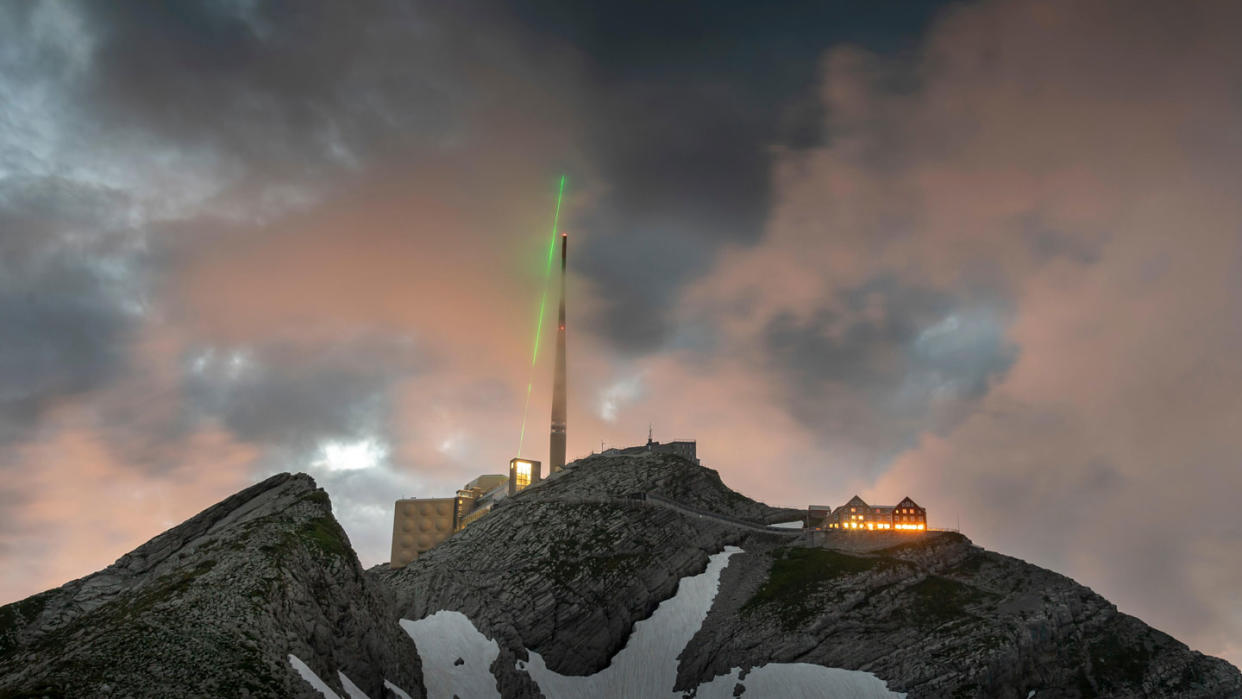Powerful laser blast used to control lightning for the first time

For the first time ever, scientists have used lasers to redirect lightning toward a safe target.
The experiment, which took place atop Säntis mountain on the northern edge of the Swiss Alps, is the first real-world demonstration that intense bursts of light can be used to fish for lightning from storms, and redirect it to a safe location.
Scientists have previously used lasers to bend the path of electricity in the lab, but achieving this outside is challenging. After hauling their laser to Säntis' summit at an altitude of 8,200 feet (2,500 meters), the researchers fixed it to a 407-foot-tall (124 m) transmission tower there and pointed it at the sky. Then, by firing the infrared laser at passing storm clouds in short blasts of roughly 1,000 times per second, they corralled a path for lightning to hit the tower four times in six hours. The researchers published their findings Jan 16. in the journal Nature.
Related: Why does lightning zigzag?
"Although this research field has been very active for more than 20 years, this is the first field-result that experimentally demonstrates lightning guided by lasers," the researchers wrote in the study. "This work paves the way for new atmospheric applications of ultrashort lasers and represents an important step forward in the development of a laser based lightning protection for airports, launchpads or large infrastructures."
Lightning emerges when atmospheric static electricity, generated by the friction of ice clumps and rain in stormclouds, separates electrons from atoms. The negatively charged electrons then pool at the stormcloud's base and attract positive charges from the ground. As electrons steadily accumulate, they begin to overcome the resistance of the air to their flow, ionizing the atmosphere below them as they approach the ground in multiple forking (and invisible) "leader" paths. When the first leader path makes contact with the ground, electrons hop to the earth from the point of contact, discharging from the bottom up in a flash of lightning (called the return stroke) that travels to the top of the cloud.
RELATED STORIES
—'Gigantic jet' that shot into space may be the most powerful lightning bolt ever detected
—Billions of lightning bolts may have jump-started life on Earth
—'Superbolts' are real, and they flash up to 1,000 times brighter than regular lightning
Lightning rods shield buildings by providing leader paths with a quick and safe route to discharge electrons into the ground, but the area they protect is limited by the rod's height. To get around this limitation, the scientists beamed their powerful laser bursts at the air near the rod, tearing electrons from air molecules and sweeping those molecules away to create an electron trail between a nearby stormcloud and the rod for the lightning to travel along.
Sure enough, four strikes hit the rod during the six hours of the laser's operation, easily surpassing the usual frequency of strikes on the rod of roughly 100 times per year. Even more direct evidence of the experiment’s success came from one of the strikes that was captured by cameras in slow motion as it zig-zagged onto the path cleared by the rod.
The scientists now want to replicate the effect in other locations with different atmospheric conditions, rods, lasers and pulses to see if this approach could be deployed more widely, and if lightning might strike twice.

